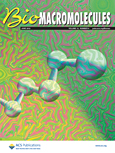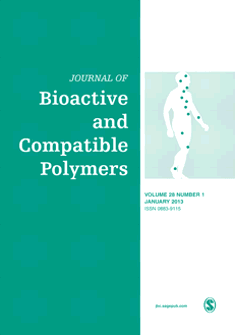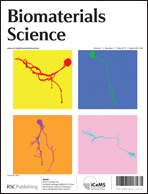
JOURNAL OF BIOMATERIALS APPLICATIONS
Scope & Guideline
Advancing the frontier of biomaterials research.
Introduction
Aims and Scopes
- Biomaterial Development and Characterization:
The journal emphasizes the synthesis, characterization, and optimization of new biomaterials, including hydrogels, composites, and scaffolds, aimed at enhancing their properties for medical applications. - Tissue Engineering and Regenerative Medicine:
Papers frequently address the use of biomaterials in tissue engineering, focusing on scaffolds and hydrogels that support cell growth, differentiation, and tissue regeneration. - Drug Delivery Systems:
The journal covers the design and evaluation of innovative drug delivery systems, including nanoparticles and hydrogels, that enhance the release and bioavailability of therapeutic agents. - Antimicrobial and Antiviral Applications:
Research on biomaterials with antimicrobial properties and their application in preventing infections in medical devices and wound dressings is a consistent focus. - Biocompatibility and Safety Evaluations:
Studies assessing the biocompatibility and safety of biomaterials in vivo and in vitro, ensuring that new materials are suitable for clinical use. - 3D Printing and Biofabrication Techniques:
The journal promotes research on advanced manufacturing techniques like 3D printing and biofabrication to create complex biomaterial structures for various applications.
Trending and Emerging
- Smart and Responsive Biomaterials:
There is a rising interest in developing smart materials that respond to environmental stimuli (e.g., pH, temperature) for controlled drug release and tissue engineering applications. - Nanotechnology in Biomaterials:
The integration of nanotechnology into biomaterials is increasingly prominent, with research focusing on nanocomposites, nanoparticles for drug delivery, and nanoscale modifications to enhance material properties. - Biomaterial-Cell Interactions:
A growing body of research is dedicated to understanding how biomaterials interact with cells at the molecular level, influencing cellular behavior and functionality in tissue engineering. - Sustainable and Biodegradable Materials:
The trend towards sustainability has led to increased research into biodegradable materials derived from natural sources, emphasizing eco-friendly approaches in biomaterial development. - Multi-functional Biomaterials:
The development of multi-functional biomaterials that serve multiple purposes, such as combining structural support with drug delivery or antimicrobial properties, is becoming more prominent.
Declining or Waning
- Traditional Biomaterials:
There has been a noticeable reduction in studies focused solely on traditional biomaterials (like metals and ceramics) without innovative modifications, as the field shifts towards more advanced composites and hybrid materials. - Passive Drug Delivery Systems:
Research on passive drug delivery systems without active targeting or stimuli-responsive mechanisms has declined, as newer technologies focus on enhancing efficacy through targeted and controlled release strategies. - Static In Vitro Testing:
The reliance on static in vitro testing methods for evaluating biomaterial performance is waning, with a growing emphasis on dynamic models that better mimic physiological conditions.
Similar Journals

BIOMACROMOLECULES
Transforming Research into Technological BreakthroughsBIOMACROMOLECULES, published by the American Chemical Society, stands as a premier journal in the fields of bioengineering, biomaterials, materials chemistry, and polymers and plastics. With a commendable impact factor that places it in the Q1 category across these disciplines, it is recognized for its influential research contributions and is ranked strongly within its scopes—16th in Polymers and Plastics and 26th in Biomaterials according to Scopus. Since its inception in 2000 and continuing through 2024, the journal has been pivotal in disseminating significant findings and technological advancements that propel the field forward. Although it does not currently have an open access option, the journal offers invaluable insights that are essential for researchers, professionals, and students engaged in the cutting-edge exploration of macromolecules and their diverse applications. With its address located at 1155 16th St, NW, Washington, DC 20036, BIOMACROMOLECULES is not just a repository of knowledge but also a vital platform for fostering collaboration and innovation within the scientific community.

International Journal of Biomaterials
Unlocking the potential of biomaterials for enhanced medical technologies.The International Journal of Biomaterials, published by HINDAWI LTD, is a premier platform for disseminating groundbreaking research in the fields of biomaterials and biomedical engineering. With an Open Access approach since 2009, this journal provides unhindered access to innovative studies and applications aimed at advancing medical technologies and improving patient outcomes. Notably ranked in the Q3 category for both Biomaterials and Biomedical Engineering in 2023, it serves as an essential resource for researchers, practitioners, and students alike. The journal's Scopus rankings, including a 49th percentile in Biomedical Engineering and a 40th percentile in Biomaterials, further underscore its growing prominence in the academic community. With contributions spanning from 2011 to 2024, the journal seeks to foster collaborative research and promote developments that enhance the understanding and application of biomaterials in healthcare.

JOURNAL OF BIOACTIVE AND COMPATIBLE POLYMERS
Innovating Biocompatibility for a Sustainable FutureJOURNAL OF BIOACTIVE AND COMPATIBLE POLYMERS, published by SAGE PUBLICATIONS LTD, serves as a pivotal platform for disseminating innovative research in the fields of bioengineering, biomaterials, materials chemistry, and polymers. With an ISSN of 0883-9115 and an E-ISSN of 1530-8030, this journal is committed to the advancement of knowledge relating to the interaction of polymers within biological systems and their compatibility in various applications. Operating since 1986, the journal has garnered a respectable presence, ranked in the Q3 quartile across multiple categories in 2023, indicating its relevance and contribution to these dynamic fields. Although not open access, the journal ensures that high-quality research is accessible to subscribers and institutions, reinforcing its importance for researchers, professionals, and students aiming to stay abreast of advancements in polymer science and biocompatibility. By fostering interdisciplinary communication and collaboration, the JOURNAL OF BIOACTIVE AND COMPATIBLE POLYMERS continues to play a crucial role in shaping the future of material applications in health, technology, and industry.

MACROMOLECULAR BIOSCIENCE
Leading the Charge in Macromolecular ScienceMACROMOLECULAR BIOSCIENCE, published by WILEY-V C H VERLAG GMBH, is a leading journal in the fields of bioengineering, biomaterials, biotechnology, materials chemistry, and polymers and plastics. With a convergence of scientific inquiry since its inception in 2001, the journal has established itself as a vital resource for researchers and professionals exploring the interface of molecular sciences and biosystems. It boasts impressive Scopus rankings, including Q1 status in multiple categories, reflecting its significant contribution to advancing knowledge and innovation in the polymer and biomaterials domains. While the journal does not currently offer open access options, its rigorous peer-review process ensures the publication of high-quality research that fuels academic discourse. Positioned in Weinheim, Germany, MACROMOLECULAR BIOSCIENCE aims to bridge theoretical understanding with practical applications, making it an essential reference for students, academics, and industry practitioners dedicated to the evolving landscape of macromolecular bioscience.

Acta Biomaterialia
Unveiling Breakthroughs in Biomaterials ScienceActa Biomaterialia, published by Elsevier Science Ltd, is a leading journal in the fields of biochemistry, biomaterials, biomedical engineering, biotechnology, and molecular biology. With an ISSN of 1742-7061 and an E-ISSN of 1878-7568, this prestigious journal has secured a remarkable position in the academic community, evidenced by its inclusion in the Q1 category across multiple disciplines for 2023. It ranks impressively at #21 in biochemistry, #16 in biomedical engineering, #18 in biotechnology, and #11 in biomaterials, reflecting its high impact and relevance to ongoing research and development. The journal provides a platform for disseminating innovative research and advancements in the design and application of biomaterials, contributing to scientific discussions that propel the field forward. Although it does not currently offer open access options, Acta Biomaterialia continues to attract contributions that advance our understanding of biomaterials and their interactions with biological systems, ensuring that researchers, professionals, and students remain informed about the latest trends and breakthroughs in this rapidly evolving area of study.

Biomaterials Science
Uniting academia and industry to revolutionize biomaterials science.Biomaterials Science is a premier journal published by the Royal Society of Chemistry that serves as a leading platform for researchers and professionals in the fields of Biomedical Engineering and Materials Science. With an impressive impact factor bolstered by its Q1 quartile ranking in both disciplines, this journal has positioned itself at the forefront of cutting-edge research, showcasing innovative materials and applications that drive advancements in healthcare and technology. Since its inception in 2013, Biomaterials Science has been committed to disseminating high-quality, peer-reviewed articles that promote scientific knowledge and collaboration among academia and industry. With a global readership and a focus on open access, researchers are encouraged to share their findings to facilitate the development of transformative biomaterials and their applications. Join a vibrant community of scholars as we explore the future of biomaterials through this esteemed publication, enhancing both scientific inquiry and practical application.

Biomedical Materials
Empowering Research in Biomaterials and Bioengineering.Biomedical Materials, published by IOP Publishing Ltd, is a premier journal dedicated to the rapidly evolving field of biomedical engineering and materials science. With a robust impact factor showcasing its influence, this journal serves as a vital platform for disseminating pioneering research from 2006 to 2024. Covering an array of interdisciplinary topics—ranging from biomaterials to bioengineering and applied chemistry—the journal consistently ranks in the second quartile across multiple categories including Bioengineering (Q2), Biomaterials (Q2), and Biomedical Engineering (Q2) as of 2023. Researchers, professionals, and students alike benefit from its contributions, exploring innovative solutions at the intersection of biology and material science. Although not an Open Access journal, Biomedical Materials remains essential in advancing our understanding and facilitating discussions surrounding state-of-the-art materials that revolutionize medical applications and enhance patient care.

BIO-MEDICAL MATERIALS AND ENGINEERING
Exploring the future of biomedical materials.BIO-MEDICAL MATERIALS AND ENGINEERING, published by IOS PRESS, serves as a vital platform for advancing the fields of biomaterials and biomedical engineering. With its ISSN 0959-2989 and E-ISSN 1878-3619, the journal has been consistently disseminating high-quality research since its inception in 1991, covering a diverse range of studies on the development and application of biomedical materials. Although currently classified in the Q4 quartile in several categories including biomaterials and biomedical engineering, the journal aims to appeal to a broad audience of researchers and professionals, fostering collaboration and innovation in translating new materials into clinical practice. Located in the Netherlands, it emphasizes the importance of interdisciplinary approaches and provides a forum for new ideas and findings that could significantly impact healthcare solutions. While not an open-access journal, it provides various access options to maximize the reach and engagement of its research. Researchers, practitioners, and students alike will find valuable insights and comprehensive studies within its pages, contributing to the continued evolution of biomedical sciences.

Tissue Engineering Part B-Reviews
Pioneering Reviews for Biomedical Breakthroughs.Tissue Engineering Part B-Reviews is a premier academic journal published by MARY ANN LIEBERT, INC, focusing on the interdisciplinary field of tissue engineering and regenerative medicine. With an impressive impact factor that places it in the Q1 category across multiple relevant fields—including Biochemistry, Bioengineering, Biomaterials, and Biomedical Engineering—this journal provides a vital platform for researchers and professionals to disseminate cutting-edge findings and comprehensive reviews. Covering a vast scope from 2008 to 2024, the journal is committed to advancing knowledge in the application of engineering principles to biological tissues, making it an indispensable resource for those at the forefront of biomedical innovation. While the journal does not currently offer open access options, its rigorous peer review process ensures high-quality contributions that are essential for academic and practical advancements. The journal's rankings in Scopus reflect its significance, catering to a diverse audience of students, researchers, and practitioners seeking the latest insights in this dynamic field.

Regenerative Therapy
Unlocking potential in biomaterials and developmental biology.Regenerative Therapy is a premier open-access journal dedicated to advancing the fields of biomaterials, biomedical engineering, and developmental biology. Published by Elsevier in Japan, this journal has been an influential platform since its inception in 2015, contributing significantly to the global discourse on regenerative medicine. With an impressive Q2 ranking in major categories such as Biomaterials and Biomedical Engineering, it is recognized for its quality of research and innovation. Researchers seeking to disseminate their findings or explore cutting-edge developments will find Regenerative Therapy to be invaluable, reflecting current trends and fostering collaborations across interdisciplinary boundaries. The journal offers open access, ensuring that high-quality research is available to a broad audience and enhances the impact of scholarly work in the regenerative medicine community.